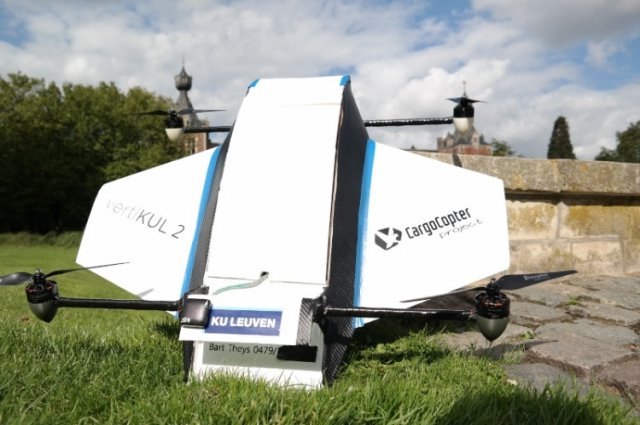Researchers in Belgium have devised a prototype delivery drone which they say could rival the likes of Amazon Prime Air and Google’s Project Wing. The University of Leuven team behind VertiKUL 2 (KUL is the acronym for Katholieke Universiteit Leuven) say the drone combines the ability of quad-copters to take-off and land vertically with both the speed of conventional aircraft and their capacity to fly long distances.
By adding wings to a multi-rotor and enabling a transition between hover and cruise flight they say they were able to decrease the required power for flying at high speeds.
Lead researcher Bart Theys told Reuters that combining aspects of multi-copters and conventional aircraft created great potential for a future drone delivery service.
“We made a combination that uses the flight efficiency of an airplane and combines this with the vertical take-off and landing of a quad-copter or a helicopter,” he said. “So we added wings and aerodynamically shaped profile to a quad-copter to make it fly fast and far.”
VertiKUL 2 takes off and lands vertically by using four propellers. Once cruising altitude is reached the automatic flight controller can tilt the craft forward, so that its top effectively becomes its nose. Using Global Positioning System (GPS), it can reach its destination quickly, using markedly less energy than other multi-rotor craft.
Researchers in Belgium have devised a prototype delivery drone which they say could rival the likes of Amazon Prime Air and Google’s Project Wing.
The University of Leuven team behind VertiKUL 2 (KUL is the acronym for Katholieke Universiteit Leuven) say the drone combines the ability of quad-copters to take-off and land vertically with both the speed of conventional aircraft and their capacity to fly long distances.
By adding wings to a multi-rotor and enabling a transition between hover and cruise flight they say they were able to decrease the required power for flying at high speeds.
Lead researcher Bart Theys told Reuters that combining aspects of multi-copters and conventional aircraft created great potential for a future drone delivery service.
“We made a combination that uses the flight efficiency of an airplane and combines this with the vertical take-off and landing of a quad-copter or a helicopter,” he said. “So we added wings and aerodynamically shaped profile to a quad-copter to make it fly fast and far.”
VertiKUL 2 takes off and lands vertically by using four propellers. Once cruising altitude is reached the automatic flight controller can tilt the craft forward, so that its top effectively becomes its nose. Using Global Positioning System (GPS), it can reach its destination quickly, using markedly less energy than other multi-rotor craft.
Upon reaching its destination VertiKUL 2 reverts to hovering mode. Onboard electronics then identify the landing platform and automatically enable the drone to descend onto it.
“When we take off it flies like a multi-copter and all the lift is generated by the four propellers,” explained Theys. “After take-off we make a transition and we tilt the whole vehicle 45 degrees and after this the wings provide a lot of lift and the propellers do not consume so much energy anymore. When we want to land we just make a transition back to hover and all the lift is provided by the propellers and we can land vertically on a very small spot.”
In outdoor tests VertiKUL has been able to travel for up to 30 kilometers (18.6 miles), with a cargo payload of up to one kilogram (2.2 lb).
The university’s first prototype, VertiKUL 1, was designed in 2014 by master’s students Maarten Verbandt, Cyriel Notteboom, and Menno Hochstenbach.
Production engineering researchers Theys and colleague Stijn Debecker felt that, although it performed impressively in field tests, VertiKUL 1 struggled in windy conditions. So they decided to construct a new model with smaller wings.
“We had to shrink the wing, which made it less efficient aerodynamically, but we compensated by making the fuselage also part of the lift producing surface,” said Theys. “To compensate further for adding extra lift in forward flight, also the propellers in forward flight deliver 50 percent of the lift because they are at an angle of 45 degrees.”
The pair says the result is a wind tolerant, efficient and fast multi-rotor. Field tests involving VertiKUL 2 being flown autonomously are now planned. “We are now ready to fly fully autonomously with VertiKUL,” Debecker told Reuters. “It’s also possible to land with very precise position of ten centimeters. We use very accurate real-time kinematic GPS for that and in the next stage we want to automatically exchange batteries and a package out of our drone.”
Debecker and Theys say they have received much commercial interest in the drone and are seeking additional funding to improve it further. After that they will face the additional hurdle of getting permission for it to take to the skies on a commercial basis.
Source: Reuters

